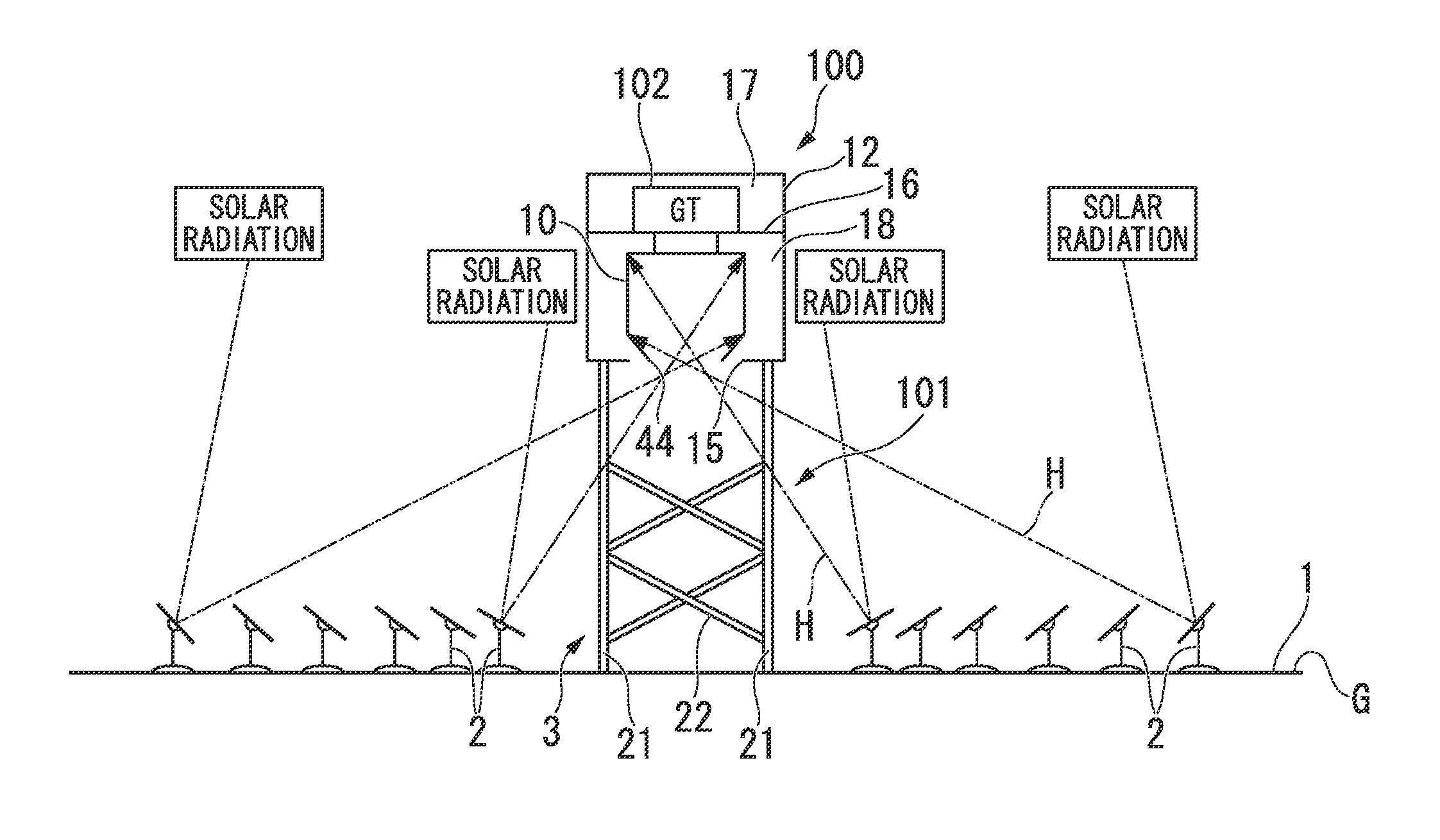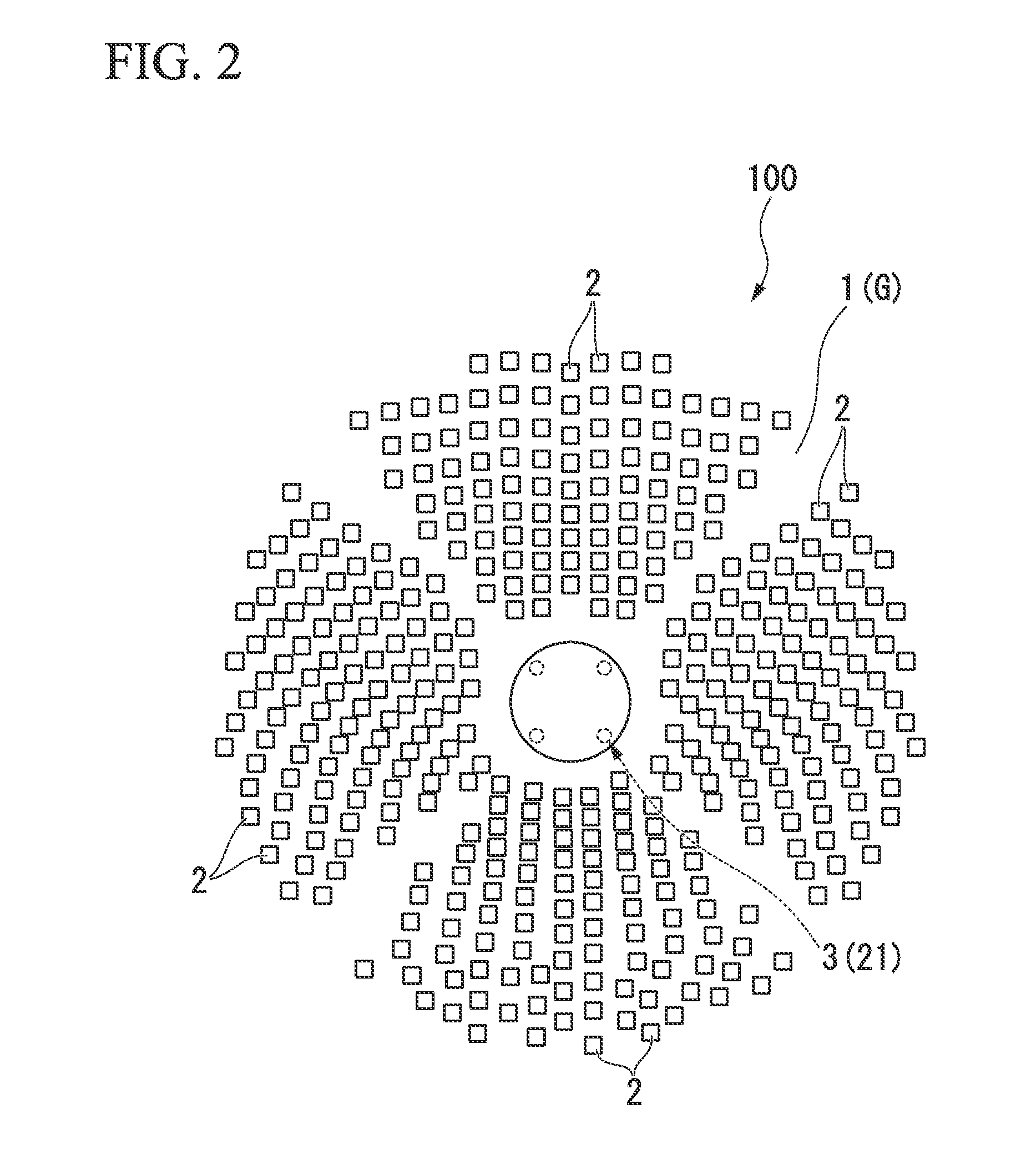Solar light heat receiver, and solar light collecting and heat receiving system
a solar light and heat receiving technology, applied in the safety of solar heat collectors, light and heating equipment, machines/engines, etc., can solve the problems of large circumferential temperature difference, inefficient thermal energy generation, and temperature difference between light receiving surfaces b>503/, so as to improve the durability of heat receiving pipes, reduce temperature difference, and reduce the effect of temperature differen
- Summary
- Abstract
- Description
- Claims
- Application Information
AI Technical Summary
Benefits of technology
Problems solved by technology
Method used
Image
Examples
second embodiment
[0088]Next, a second embodiment of the invention will be described. FIG. 9 is a partially cutaway plan view showing a heat receiving unit of the embodiment. In the above-described embodiment, a configuration has been described in which the orifice plate 63 as the constraint means is disposed in the inlet of the non-light receiving side passageway 62 of each heat receiving pipe 51, but this embodiment is different from the above-described embodiment in that the constraint means is disposed in the low-temperature header 52. Furthermore, in the description below, the same reference signs will be given to the same components and the description thereof will be omitted.
[0089]As shown in FIG. 9, a heat receiving unit 142 of the embodiment has a configuration in which a plurality of partition walls 111 is provided at the same interval in the circumferential direction of the low-temperature header 152. Each partition wall 111 is disposed at one end of the outlet of each heat receiver supply...
third embodiment
[0095]Next, a third embodiment of the invention will be described. FIG. 10 is a cross-sectional view showing a heat receiving unit of the embodiment. Furthermore, in the description below, the same reference signs will be given to the same components and the description thereof will be omitted.
[0096]As shown in FIG. 10, inside the heat receiver body 41a heat receiving unit 242 of the embodiment includes a high-temperature header 253 which is disposed along the outer periphery of the ceiling plate portion 43, a low-temperature header 252 which is disposed at the inside of the high-temperature header 253 in the radial direction, and a plurality of heat receiving pipes 251 which makes the headers 252 and 253 communicate with each other. Furthermore, the low-temperature header 252 and the high-temperature header 253 are supported while being hung on the ceiling plate portion 43 by a plurality of hook members 245.
[0097]In each heat receiving pipe 251, one pipe is divided into a light rec...
fourth embodiment
[0101]Next, a fourth embodiment of the invention will be described. FIGS. 11A and 11B are cross-sectional views showing a heat receiving unit of the embodiment. In the embodiment, the arrangement direction of the heat receiving pipes 251 is reversed in the up-down direction compared to the third embodiment. Furthermore, in the description below, the same reference signs will be given to the same components and the description thereof will be omitted.
[0102]As shown in FIG. 11A, in the heat receiving unit 242 of the embodiment, the low-temperature header 252 and the high-temperature header 253 are disposed at the lower portion in the gravity direction inside the heat receiver body 41, and the plurality of heat receiving pipes 251 extends upward from the low-temperature header 252 and the high-temperature header 253.
[0103]Further, the ceiling plate portion 43 inside the heat receiver body 41 is provided with a plurality of hook members 345 which connects the ceiling plate portion 43 to...
PUM
 Login to View More
Login to View More Abstract
Description
Claims
Application Information
 Login to View More
Login to View More - R&D
- Intellectual Property
- Life Sciences
- Materials
- Tech Scout
- Unparalleled Data Quality
- Higher Quality Content
- 60% Fewer Hallucinations
Browse by: Latest US Patents, China's latest patents, Technical Efficacy Thesaurus, Application Domain, Technology Topic, Popular Technical Reports.
© 2025 PatSnap. All rights reserved.Legal|Privacy policy|Modern Slavery Act Transparency Statement|Sitemap|About US| Contact US: help@patsnap.com



